
News release: 21 Apr, Kupang | |
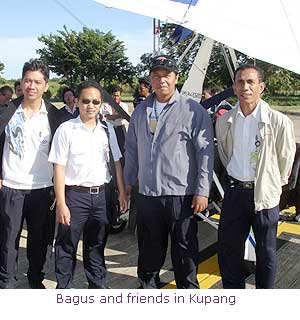 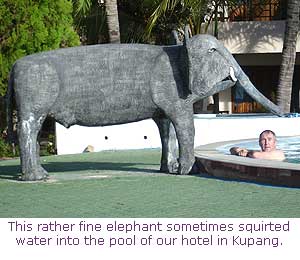 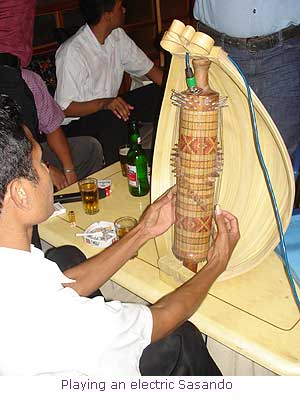 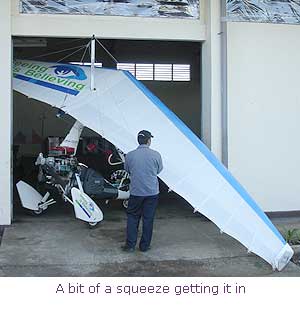 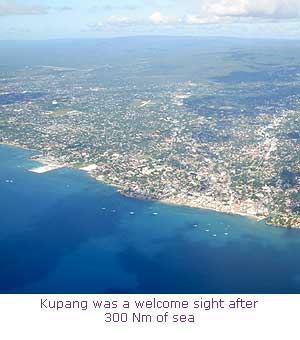 | Nyoman, my taxi driver's best word was "Sorry". Sorry he was a bit late coming to my hotel to take me to the restaurant; sorry he didn't understand me the first time Etc. It's no good asking for a beer in Indonesia, "sorry, I do not understand what you want". Say you want a 'Bintang' however and they understand immediately; it's the only kind of beer you can get, jolly nice it is too. Bima is predominantly a Muslim area and this restaurant is the only place in town allowed to serve it - and only to foreigners. Apparently quite a lot of foreigners do come here; either on their way to Lakey peak on the South side of the island for the surfing; "tenth best surfing place in the World" Nyoman said, or, as Bima is the nearest airport, a lot pass through en route to the Komodo ferry to see the dragons. I was also told about the massive gold and copper mine on the west coast of the island at Batu Hijau which began commercial production in 2000. Unfortunately I'd already passed this or I would have probably diverted a bit to take a look; it must be quite a sight as they're currently digging no less than 600,000 tons of rock per day out of a huge hole from which 145,000 tons a day of ore goes through the processing plant making it Asia's second largest copper mine after the one at Freeport in Papua. My brother Luke has texted me the number of the met office in Darwin; apparently there's someone there 24 hours. It will be most useful to be able to talk to a real live person. To tell the truth, given the North easterly winds we've had lately I think it's rather unlikely we'll be going direct to Darwin; Truscott sounds a much better bet, it's nearer and less into wind. He tells me that international aviation convention allows us to go there without any special dispensations from Canberra which is good news. Next morning Nyoman was extra sorry to be late picking me up, he'd had a flat tyre in the night. The spare was completely bald, he was sorry, but best to get the punctured one repaired before we set off for the airport, sorry, but just in case. It was still dark but luckily there was a tyre repair man already up who fixed it with a sort of hot vulcanizing process I've not seen since I was last in Africa. Sorry it all took so long. We set off like Michael Schumacher with engine pinking like a bag of nails down the rather narrow curvy coast road liberally scattered with carts, cyclists and pedestrians off to work. "It doesn't matter if we get to the airport a bit late" I said [lets just get there intact shall we?]....sorry. I've finally discovered how airport charges are calculated in Indonesia, and it isn't simple. Normally these things are calculated in the privacy of an office somewhere but they don't really have an option at Bima as the airport administration building only consists of one room. When I arrived there just after dawn, the lady in charge was doing an incredibly complicated looking sum on a bit of paper whilst referring to a rather scrappy looking manual containing the formulae. She announced that my bill would be 300 and something dollars. This didn't seem right to me and I asked to look at the book. The way it is done is on the basis of adding up multiples, the bigger the aircraft, airport, number of passengers, quantity of freight Etc. the more multiples you add together and then you divide it by some rather incoherent constants to get the solution. Well it was clear I had a low rating in terms of freight and passengers, I discovered that while Jakarta as an airport had a multiple of five, Bima had a lowly rating of one. So far then, on the basis that one times one equals one things were looking good, so what about the aircraft? In the back was a reference of a large number of aircraft from Antonovs right through to Zlins; and she'd decided the nearest thing to my aircraft type was a G450 which is a fairly large executive jet carrying a multiple of 6. Of course there was no GT450 but what I did find was what they called a 'Cessna Citation 150', I suppose a regular C150, which the book said had a takeoff weight of 750 Kg, and which significantly carried a multiple of only one. I pointed out that I was around about half that weight and so really I should only have a multiple of a half. Initially she agreed to this but the new calculation worked out so they owed me money which sounded good to me, but not so much to her. I agreed a multiple of one would be OK then, and the fee came out to an entirely reasonable $22. The tide was out and the airfield was dry when I took off, I gave the small crowd which had gathered to watch a bit of a fly-by as I departed which they seemed to enjoy, then it was a few miles across the island, over the surfing beaches and out to sea. The engine oil pressure is still fluctuating as much as it's ever done, it is supposed to be somewhere between 2 and 4 bar but bounces wildly between 1.5 and 5. I continue to trust what Nigel Beale said which was "so long as it doesn't go below 1 you'll be fine". It is a bit annoying though as it trips a red warning light whenever it's out of range and I've become immune to it which means I probably wouldn't notice it if some other engine parameter like oil or water temperature was out of limits. It's probably just a sticky oil pressure relief valve but I've been reluctant to fiddle with it because no place we've had a stop long enough to do maintenance was very suitable for doing test flights and the next flight always seemed to be a long sea crossing which isn't the best place to find I'd made it worse. Like so many other things it all comes down to poor preparation by you-know-who before the start of the journey. My route took me via Sumba, there was an option I could land there at Waingapu but I knew there was only the ghastly premium available, so no point unless things were going particularly badly, which they weren't, so I passed by 20 miles or so off-shore. With 200 miles of sea ahead I did quite a number of short pumpings from the reserve to keep the main tank more-or-less completely full. Just past the half-way mark I finally got bubbles in the pipe which showed the reserve was empty, but as the main is a bit bigger than the reserve I was fairly confident I would reach Kupang. As has been the case in the last few days there were big black clouds about, but my luck was holding and the weather was good on my exact route, if a little slow. I managed to make contact with Kupang about 70 miles out, for a while they were a bit confused that my ETA was still about an hour and a half. Given that only the last five miles of the flight were over land I'm inclined to think we'd have been swimming with the sharks and crocodiles about 20 miles off Timor had Miles been with me. There's something quite seminal about getting to Kupang. This is it, next stop Australia, but with perhaps the longest flight of the journey for which we've had to make special preparations. Certainly I know people at home have been worried about this moment, and to some extent I have too. Of course we're well equipped with life jackets, emergency beacons, life raft, satellite phone in a waterproof bag and even shark repellent, but for me, I think it's those 'salties', the giant crocodiles they get here abouts which I don't really like the idea of, but in reality I don't expect you get them out to sea. Do you? In fact the machine has been jolly reliable up to now and there's no reason to think it won't continue to be. What's more, in some way, today's flight has been more risky, 300 miles of sea with what probability of prompt rescue? I didn't see hardly any boats. I know there are Australian oil installations all over the Timor sea and they are sure to have great big helicopters so I imagine the chance of prompt and effective rescue there is quite high. Still - there's the unknown of what happens next when you actually hit the water in a trike; something I've never done and don't really want to try. As I taxied in to Kupang Jon was waiting triumphant with a big cardboard box containing the long range tanks from P&M in Rochdale. With little apparent concern that I was actually quite knackered after my five and a half hour flight from Bima I was immediately taken on a tour of potential hangars where I could start work fitting them. A shed containing broken down tractors, a rather fine steam roller and a Badminton court was found round the back of the fire station which was a bit tight getting to and even tighter getting into. I had to take the radio antenna off the kingpost and it fitted through with a millimeter to spare. Jon, and I suppose the bank still want to know exactly when we'll be in Sydney. I don't know as I still haven't got any maps of Australia and I don't know what the weather forecast is for the Timor sea, we could be here for days. Perhaps I misunderstood, but he then hung around like he wanted to make sure I got on with the job rather than idling around gossiping to firemen or passers by or something. In any case it was quite a big job planning and executing a complete re-plumbing of the entire fuel system in such a way that I knew it would definitely work the first time it was used in the middle of an ocean. Until now, I've had a valve by Miles' left foot which I switch on and then I turn on the electric pump which transfers fuel from the 40 litre reserve tank into the main tank. We've now got 40 extra litres, 20 in each pannier, with a new three-way valve mounted between my legs which is left or right or off in the middle. It's got a bit of clear pipe leading from it so I can see bubbles, I don't think it does the pump much good to be running dry. It is fairly simple to operate; the main reserve is the same as before, just make sure the new valve is in the central 'off' position. To pump from left or right, just make sure the main tank valve is 'off' and the new valve is on 'left' or 'right' before pumping. I think it will work. I got the bulk of it fitted that evening but when it got dark I declared it was time for a Bintang. I thought I detected a certain disappointment now it was clear that Miles and I wouldn't be going anywhere tomorrow. In any case I haven't refuelled or started on paperwork of which there's bound to be some even if Bagus, Suganda's man here seems quite clued up, since our next flight is an international one - our last international flight to the 22nd country of the journey. For ages Miles was telling people that our route to Australia was via East Timor. People have heard of East Timor because in 2002 it became the 21st century's first new independent nation and the recent trouble with presidential elections in the news. I think Miles thought this because you-know-who told him, and you-know-who obviously doesn't have a very good grasp of geography, and didn't have any maps of this part of the World anyway. In fact we're in West Timor which is very much part of Indonesia. As far as going to Darwin is concerned there is no distance advantage by going to Dili in East Timor, in fact as Dili is on the north coast and there is a very high mountain range going up to 8,000 ft to cross on the way to Darwin there would be a distinct disadvantage in going there. There was a chap playing an electric Sasando in the hotel that night. It's a traditional musical instrument from West Timor. It is a unique kind of plucked instrument, a considerable number of strings are fastened around its main resonator and then it has a second resonator made from leaves of Palmyra palm which can be adjusted like a fan. It takes considerable dexterity to play, especially as the musician can't see half the strings. He was very good at it. I'd asked Jon back in Penang to get some Australian dollars because if we're going to Truscott then as far as I knew it was just a shed and a strip and I didn't suppose there would be an ATM, and we'd need something to pay for fuel. I've got some Rupiah but hardly any USD left but in any case it seemed unlikely either would be of much use in the middle of nowhere in Australia. He didn't get any, and there isn't any here, so we could be in a bit of a fix if we don't go directly to Darwin. Jon is going to Darwin tomorrow with all our stuff, we're taking absolutely nothing which isn't vital. Originally I was planning to send Miles' navigation computer too as it's quite heavy but he convinced me we should keep it on board. My Aerad guide contains lots of stuff about flying in Australia, notably the 'Flightwatch' system and 'SARtimes' both of which I think are designed so someone will start looking for you if you don't turn up in time. It looks rather complicated compared to standard flight plans which we usually do, but I'll study it a bit more carefully tomorrow after I've finished sorting out the machine and paperwork. I rang the met office in Darwin more to see whether the number my brother Luke gave me worked than anything, they say the wind out in the Timor Sea tomorrow will be a typical 'Nor-Easter', ten to fifteen knots. Rather what I expected and not very good for getting to Darwin. Still, we're not going anywhere until I've finished sorting out the fuel system. Truscott is 167 miles nearer and despite the money problem seems a much more attractive proposition. |


